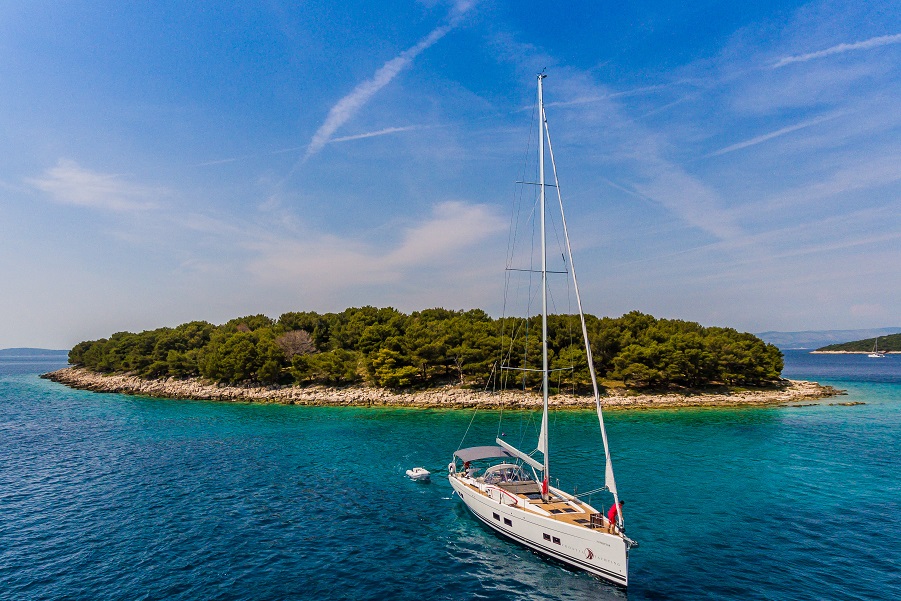Miljenko and Dobrila: Meet Kaštela's Romeo and Juliet

Table of Contents
Everyone knows about William Shakespeare’s ‘Romeo and Juliet,’ a timeless and tragic story about two young Italian star-crossed lovers. Their love, forbidden by their powerful families, the Montagues and Capulets, ultimately results in bloodshed. First premiering in 1597, Romeo and Juliet quickly became one of Shakespeare’s most popular and performed plays. And no matter where in the world you are today, it’s impossible not to know about this famous story, especially since it has been adapted for stage, film, musical, and opera venues countless times.
Today, however, we’ll entice you with a lesser-known and local tale coined the ‘Croatian Romeo and Juliet.’ A tale that also has inspired writers, playwrights, painters, opera composers, and entertaining melodies. Today, we’re bringing you to Kaštela to uncover its most famous love legend - Miljenko and Dobrila.
The legend of Miljenko and Dobrila takes place in Kaštel Lukšić, part of the seven individual Kaštela settlements between Split and Trogir. Like Romeo and Juliet, Miljenko and Dobrila were young and in love with quarreling families, bringing the story to a tragic end.

Namely, two Trogir noble families, Vitturi and Rosani, owned estates and castles in Kaštel Lukšić at the end of the 17th century. The noble Vitturi family had a daughter Dobrila, and the noble, Rušinić (Rosani) family had a son Miljenko. Miljenko and Dobrila quickly fell in love after meeting, though their feuding families forced them to see each other secretly. The two found a way to meet, mostly thanks to one maid named Antica. But as most sneaking around ultimately gets caught, it didn’t take long for the Vitturi and Rosani parents to learn about their relationship. In an effort to keep them separated, Dobrila was put under the strict supervision of her mother, Countess Marija. At the same time, Miljenko was sent away to Venice, according to the advice of a lawyer. Worried that separation would not be enough, Dobrila's father, Count Radoslav, knew he had to take even more extreme measures, arranging a marriage for Dobrila to the much older nobleman, Druzimir. Countess Demetria, Dobrila's aunt, was an opponent of the arranged marriage, considering it wildly unfair.
Miljenko was eventually sent a message about the wedding by a soldier from Kaštel Lukšić, which prompted his arrival back home. Miljenko endeavored to prevent the marriage as the two were about to say their vows in front of the parish priest, Don Mavra, and several astonished wedding guests. Dobrila's vengeful father then imprisoned his daughter at the St. Nicholas Monastery in Trogir. Miljenko was relentless in his efforts to save Dobrila, and a physical altercation erupted, resulting in a run-in with the law. With the consent of Miljenko’s father, Count Adalbert, Miljenko was exiled to a Franciscan monastery on the islet of Visovac, located on the Krka River near Šibenik.
His isolation didn’t turn out to be all that bad, as Miljenko met a local villager there named Božica, who turned out to be Dobrila's wet nurse once upon a time. Miljenko sent a message through Božica to his beloved Dobrila, asking her to escape the Trogir monastery and meet him nearby. Dobrila managed to run away after successfully deceiving the monastery's elder, abbess Gertruda, but her freedom didn’t last long. Once she escaped, Miljenko was nowhere to be found. Dobrila wandered alone during a stormy night, searching for Miljenko. She was ultimately caught by ‘hajduks’ or armed peasants hired by Count Radoslav to kill Miljenko.
After hearing of their plan, Mijenko had to act fast and disguised himself as a friar to confuse the hajduks to stay alive. However, he also confused Dobrila in the process, with the young girl believing Miljenko was actually ordained. She’d quickly lost hope of their secret marriage in Visovac. Count Radoslav learned that his daughter fled the monastery and had to undo his family’s shame - and mostly, gain revenge. Radoslav thus extended a hand of reconciliation to Miljenko's always benevolent father, Count Adalbert, after which they sent three emissaries to Visovac to persuade Miljenko and Dobrila to return home to have a solemn wedding in Kaštel Lukšić. The Kaštela lovers naively accepted their parents' offer.
Dobrila's father, however, could not fathom his daughter living with the noble Rušinić family - or that this would mean Miljenko’s victory. Overwhelmed by hatred, Radoslav reacted. He killed his son-in-law in front of his castle in Kaštel Lukšić on the evening of their wedding in the summer of 1690. As many tragic love stories end, Dobrila died of a broken heart a few months later. Her last wish was to be buried next to Miljenko at St. John’s Church in Rušinac. Today, there is a tombstone at the church that reads: "May God Rest the Lovers’ Souls."
The legend of Miljenko and Dobrila was retold as a typical folk tale when families would meet in the squares, on the waterfront, and the streets during holidays and celebrations. However, the story was only first written down by Trogir vineyard owner Marko Kažotić in his novel ‘Miljenko and Dobrila’ in 1833. In the preface, Kažotić points out that to write this novel, he took over the tradition from an unnamed writer, which was written in Illyrian or Croatian, and emphasized that it had only been passed down by word of mouth until now.
“I set my sights on a legend of a nameless writer, written in the Illyrian (Croatian) language around 1679, according to which I undertook to narrate the event.”
‘Miljenko and Dobrila’ was then published in Italian in Zadar, although it is considered a Croatian romantic work. The first attempt to translate Kažotić's novel was started by the Croatian writer and statesman Ivan Mažuranić, though Mažuranić passed away while his work was in progress, leaving behind 25 pages of translation. Today, the manuscript is kept in the university library in Zagreb. The novel experienced its greatest popularity in Dalmatia when Kažotić's novel was translated into Croatian, thanks to Bartul Matijaca, a teacher from Kaštel Lukšić. The first dramatic adaptation was written by Matija Ban in two versions: ‘Miljenko and Dobrila’ and ‘The Death of Count Radoslav’.

Arturo Porlitz published the lyric drama ‘Miljenko’ in Trieste. Librettist Antonio Ghislanzoni from Padua and Neapolitan composer Salvatore Strino created the first ‘Miljenko and Dobrila’ opera. Milivoj Koludrović composed the first Croatian opera of ‘Miljenko and Dobrila’ performed for the first time at the Croatian National Theater in Split. In 1968, a comic was even published depicting the two lovers! Many Croatian singers wrote songs inspired by the Kaštela lovers in the years that followed, with music videos filmed at these historic Kaštel Lukšić locations. The children's home in Kaštel Lukšić, located not far from Miljenko and Dobrila’s final resting place, is named also after the star-crossed lovers.
The love affair of Miljenko and Dobrila still permeates Kaštela today, as the settlement aims to brand itself as a city of love and lovers through this tragic legend. Thus, every summer, the Kaštela Tourist Board organizes the ‘Days of Miljenko and Dobrila’ under the slogan ‘Kaštela - the city of love and lovers.’ A vibrant program accompanies the event.
In 2022, when Kaštel Lukšić celebrated its 540th anniversary, a rich program through the ‘Days of Miljenko and Dobrila’ event presented the cultural and historical heritage and localities where the noble families lived: the Rušinić (Rosani) family castle (circa 1482), St. John the Baptist Church where Miljenko and Dobrila were buried, Vitturi castle (circa 1487), and the old church of the Assumption of the Blessed Virgin Mary (circa 1530) where Miljenko and Dobrila were married.
The play ‘Legend of Miljenko and Dobrila’ has been staged in these locations since 1953, and a series of programs dedicated to the memory of this young couple have been held continuously since 2012, with concerts of the most beautiful love songs, romantic films, readings of the most enchanting love verses, and numerous other manifestations.
Miljenko and Dobrila’s love story continues in Kaštela, just as their love lives forever.
















